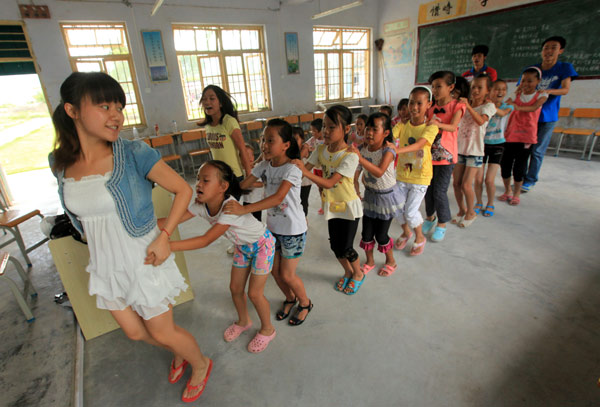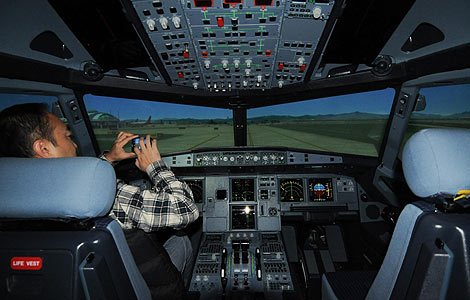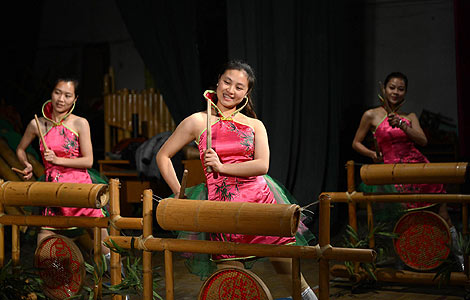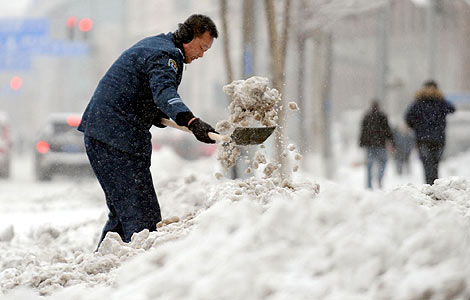
Mud was the only material that Qiu Hui, a pupil from a poor village in East China's Fujian province, could sculpt with before he received a "love package" from a charity in Beijing.
 |
|
Students from Guangxi University of Science and Technology play with pupils in Tantou township, Liuzhou city, Guangxi Zhuang autonomous region, in July. English, dancing, painting and calligraphy classes were held for the pupils during summer vacation. Tan Kaixing / for China Daily |
"I love the pieces of modeling clay in the parcel I received. They smell good and have beautiful colors. In the past, I had to dig mud from farmland, and everything I kneaded with mud looked drab," said Qiu, a sixth-grade student from Changting, an impoverished county in the mountainous area of western Fujian.
More than 90 percent of the pupils in poor rural areas said they love classes in music, arts and physical education, according to the latest survey conducted by the China Foundation for Poverty Alleviation. It polled more than 2,000 pupils and 47 principals from rural primary schools in nine provinces.
However, the survey revealed that primary schools in poverty-hit rural areas made little investment in providing quality arts education for their students.
Some 88 percent of schools polled invested less than 500 yuan ($78.50) in buying or renewing arts supplies and about 56 percent of the surveyed schools spent less than 500 yuan purchasing instruments for music classes every semester.
It also found that only two in every 10 students had musical instruments and 13 percent had drawing books.
"Our greatest concern is that rural students are falling behind their urban counterparts in aesthetic sentiment and creativity. The effect is invisible but profound and lasting," Chen Hongtao, deputy executive director of the foundation, said in an interview with China Daily.
Weak arts education at the elementary level is commonplace in vast rural regions and will worsen the inequality between rural and urban areas, said Chen.
Arts, music and physical education have been marginalized in rural schools as a result of the exam-oriented educational system. Schools put limited resources into main subjects, said Xiong Bingqi, an education commentator and deputy director of the 21st Century Education Research Institute.
To change the situation, the foundation launched the "love package" project in 2009. Each donation of 100 yuan can buy a schoolbag filled with more than 100 arts supplies, including drawing books, colored pencils and a kettle. The foundation can afford to mail either a music bag or a sports bag to an eligible school once a donor gives 1,000 yuan. Those bags are full of sports equipment or musical instruments.
"Books, pens and kettles are so common in most people's eyes, but they are luxurious and fancy for my students in this poor village," said Wang Yanfang, a teacher from Guxianping Primary School, a beneficiary school in Badong county, Hubei province.
The survey also found that almost 85 percent of the polled schools did not have professionals to teach music, arts or physical education. Mathematics or Chinese teachers teach these classes, and more than half of them have never received any specialized training.
"So the arts classes in rural areas are usually simplified to worrisome levels, the physical education class is all about calling students to line up and run, and the music teachers simply teach their students to sing pop songs," said Chen.
The foundation is considering selecting hundreds of teachers from rural primary schools to receive training in Beijing to design games and group activities.
By the end of 2011, the foundation had raised more than 230 million yuan for the project and had sent parcels to more than 6,200 primary schools, benefiting more than 2 million pupils in rural areas, according to statistics on the foundation's website.
Chen said there is a long way to go to benefit all poor rural students.
He said there are 592 national-level poverty-stricken counties in China while the project has only covered about a third of all primary schools in 300 counties.
"The project's coverage for students and schools that cannot afford arts supplies is still small, and more is needed when new students start schooling every year," he said.
Education commentator Xiong urged government to take the lead in improving the teaching conditions in rural schools, adding that civil organizations can only play a supplementary role.
Contact the writer at hedan@chinadaily.com.cn







